Today, dog owners have a huge variety to choose from when it comes to what to feed their canine  companions. While we all want our pups to live long, healthy lives, it is important to be informed about what we feed them. Unfortunately, there are a number of ‘trendy’ and ‘fad’ diets, and a great deal of inaccurate information online. One can easily become confused or even misled by slick marketers or uninformed influencers when it comes to your pet’s health and well being.
companions. While we all want our pups to live long, healthy lives, it is important to be informed about what we feed them. Unfortunately, there are a number of ‘trendy’ and ‘fad’ diets, and a great deal of inaccurate information online. One can easily become confused or even misled by slick marketers or uninformed influencers when it comes to your pet’s health and well being.
When it comes to dog food diet fads and trends, raw food has attracted attention and is widely available in pet stores. But does eating raw really benefit your dog’s health? Could a traditional kibble diet made correctly with premium ingredients, actually provide better nutrition and overall health at a fraction of the cost? In this article, we will dive into the raw vs. kibble debate by defining each way of feeding your dog and showing you why one is clearly the better option if done properly.
If you spend much time at all in pet stores or researching natural pet food options for your precious pup, chances are you have stumbled upon the phrase ‘raw food diet’. Raw food proponents theorize that since the diet of wild canines (like hyenas and wolves) consisted mainly of raw meat and bones, that today’s domesticated dogs should be on that same kind of diet. (Even though our dogs descended and evolved greatly over the past 12,000 years.)
If you are not convinced that your dog is not the same as a wolf, consider these indisputable scientific facts:
- There are 36 parts of the genome (DNA) that differ between dogs and wolves, 10 of which play a critical role in starch digestion and fat metabolism. (A genome is an organism’s complete set of DNA, including all of its genes).
- These genetic differences in the genome between dogs and wolves include the ability of dogs to digest carbohydrates and fat (for energy), which was a crucial step in the early domestication of dogs and enabled dogs to obtain energy efficiently from food. (Raw diets generally ignore carbohydrates, which means your dog’s body has to work harder to obtain the necessary energy the brain and organs need to survive. That also means the organs are getting taxed by working to derive energy from meats.)
Typically, a raw food diet consists of raw meat and bones supplemented with fresh fruit or vegetables. There are two main types of raw food diets: commercial and home-prepared. The former tends to come in patty or nugget form and includes mostly raw meat, with some kind of raw fruits and vegetables mixed in.
Home-prepared raw food diets for dogs vary from one household to the next. Households who choose to feed their pup a home-prepared raw meal must be prepared to set aside the time to put together multiple meals per day consisting of raw meat, bones, and supplemental ingredients. While this method of feeding dogs attempts to mimic the diets of wild canines over 12,000 years ago, it is time-consuming, extremely expensive, and difficult to be consistent – among an array of other potential health and safety issues. It is worth mentioning here that while it is trendy for marketers to tell you that “your dog is a wolf, so feed it like one” the fact is today’s dogs have been domesticated for well over 12,000 years or so and as such, have dramatically different lifestyles, differences in how they procure food, and also have different energy requirements. In the wild, dogs would travel in packs, sometimes not eat for days in between hunts, and were extremely active. They also had much shorter lifespans from living outdoors and being subjected to the elements, pests, and predators. Therefore how and what they ate then is very different from the lifestyle and nutritional requirements of domesticated dogs today.
Kibble was first invented 50-60 years ago, with the intent to provide a consistent method to feed dogs and cats, and since that time, it has become the most popular choice of giving our pets the nutrients they require. While dry kibble as a meal may not seem to be particularly appetizing to the human palate, understanding the process of how kibble is made can help us realize why kibble dog food and kibble cat food is the best diet choice for our pets.
Like most things in life, there can be huge differences in the quality of products, and pet food is no exception. Several factors can affect the quality of pet food, including: 1) Experience of the nutritionist who developed the diet, 2) Quality of the raw ingredients used and 3) The integrity of manufacturer and the methods they follow to blend, cook, and prepare the kibble.
In order for any pet food to be sold in the US, it must state on the label if it is complete and balanced, and also whether it adheres to the AAFCO (Association of American Feed Control Officials) guidelines for the species. The formula should be developed by an experienced nutritionist who understands how various ingredients work together in combination to provide the nutrient requirements. Kibble provides convenience to pet parents to feed their pet each day, and peace of mind that their pet can be healthy by consuming the diet. When a nutritionist creates a kibble formula, they first take into account the needs of the animal, the nutrient values of the raw ingredients, and how cooking those ingredients will affect the final product. Experienced nutritionists take into account cooking temperatures, storage conditions and shelf-life timelines that retailers and consumers require for pet foods. So the formula itself, and the production process anticipate various conditions from the raw materials all the way to the end of the shelf life to ensure that your pet will have the guaranteed level of nutrition required, regardless of when the kibble is consumed within the shelf-life timeline.
Much like making a cake in your home, to produce kibble, manufacturers first start by blending and mixing together the various raw ingredients. Depending on the specific formula, these ingredients might include a variety of specific meats, fish, poultry, fiber sources, carbohydrates, vegetables, fats/oils, and supplemental vitamins/minerals. The mixture is put through an extruder or oven, which cooks the blended ingredients and shapes the pet food into bite-size pieces. After cooking, the moist kibble will move slowly along a conveyor with heated air dryers to slowly reduce moisture to create the dry kibble that we are familiar with purchasing from the pet store. During production, the extruder has computer-automated sensors that monitor the key requirements such as protein, fat, fiber, moisture and the “percent cook” of the blend. This ensures that the kibble produced meets the specifications set by the nutritionist. If there are variations, the operator will stop the extruder, make adjustments, and then remove any production that was below the specifications.
While understanding the manufacturing process behind making kibble is interesting, it also helps us to understand that dry kibble as a food source is not so unusual after all. In fact, if a diet was made specifically for humans, we could also be completely capable of living a healthy life eating only kibble (If it was formulated to meet human nutrient requirements which are different from those of dogs and cats). This realization can help us understand the next important truth about kibble pet food: Not all kibble is created equal.
Raw vs Kibble Dog Food: Why Kibble?
There are a number of benefits of feeding a kibble diet which, when compared to the many risks of raw food diets, make kibble the clear choice in the raw vs. kibble debate. There are numerous options of super premium, natural, wholesome kibble brands on the market. Kibble has been scientifically proven to be more efficient when it comes to providing your pup with the proper nutrition in every bite. Now, let’s take a look at why the risks of the raw food diet make it an unsafe choice.
Raw vs Kibble Dog Food: Why Kibble?
There are a number of benefits of feeding a kibble diet which, when compared to the many risks of raw food diets, make kibble the clear choice in the raw vs. kibble debate. There are numerous options of super premium, natural, wholesome kibble brands on the market. Kibble has been scientifically proven to be more efficient when it comes to providing your pup with the proper nutrition in every bite. Now, let’s take a look at why the risks of the raw food diet make it an unsafe choice.
Risks and Downfalls of the Raw Food Diet
Safety Risks
Simply put, a raw diet is unsafe for dogs, cats and humans according to the FDA, noted scientists and many veterinarians. Studies show that raw dog and cat foods have been found to contain an array of harmful bacteria including Salmonella, E. Coli, Campylobacter, Clostridium botulinum, and Staphylococcus aureus. All of these are known to be human, feline, and canine pathogens. Your pup can shed these bacteria in his stool, which can be transferred to areas around the house as your pet moves about.
The bacteria can be picked up by human members of the household, making them very sick. These bacteria can pose a very serious health risk to children, the elderly, and anyone who is immunocompromised. Additionally, bacteria like Neospora caninum, Nanophyetus salmincola, and Trichinella spiralis are frequently found in raw meats and are capable of making the dogs themselves very sick. All of these bacteria are potentially life-threatening for your dog. In particular, if your home has children, infants, elderly, a pregnant woman, or anyone with a weakened or compromised immune system, raw pet food is especially unsafe and risky.
Case report studies of animals eating raw diets showed contamination with Salmonella, E. coli, Campylobacter jejuni or Toxoplasma gondii and increased numbers of infections attributable to Echinococcus multilocularis. These bacteria and pathogens also negatively affect the microbiome of the dog or cat by altering the balance of bacteria in the gut, and in turn, negatively affect gut health. Scientific published studies that document this include: Śmielewska-Los et al., 2002, Dubey et al., 2005, Lopes et al., 2008 Lenz et al., 2009, Taylor et al., 2009, Antolova et al., 2009.
Over the years, some raw food brands have implemented either irradiation treatment or high-pressure pasteurization (HPP) to their products before shipping as a kill step for any pathogens. Due to the nature of raw uncooked meats, once raw food diets are defrosted in your home, there is a significant risk of dangerous bacteria and pathogens developing very quickly. This is why raw food marketers direct customers to use the defrosted food quickly and not leave the raw defrosted food in your pet’s bowl longer than the immediate feeding time. Raw food serving also requires that you clean and disinfect working surfaces and utensils. Your pet’s food bowl must be thoroughly washed and disinfected after they finish each meal to prevent the growth and spread of harmful bacteria.
While there are plenty of personal opinions either way, among pet store owners, veterinarians, and bloggers, the facts speak for themselves regarding risks and nutritional deficiencies of feeding raw dog and cat foods. The FDA has issued numerous warnings regarding the risks of feeding raw pet food diets, such as this article: https://www.fda.gov/forconsumers/ucm403350.htm
In addition, feeding your dog raw food with bones can cause choking, intestinal perforations and/or blockage, and damaged or
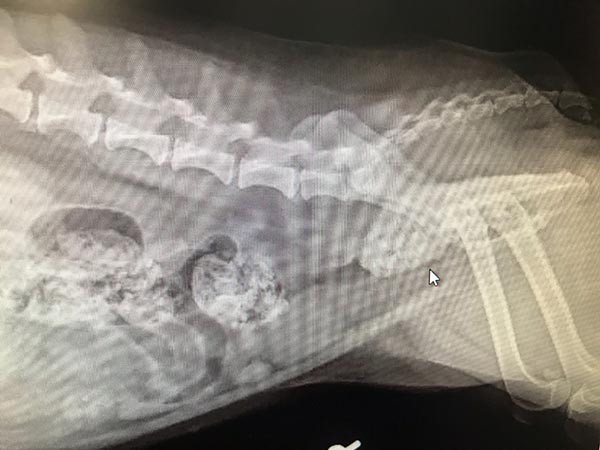
Veterinarian XRAY of ingested bones seen within the colon on dog’s radiograph
broken teeth. These are serious health concerns for dogs and are not to be taken lightly. Bones can cause obstruction or perforation of the esophagus, stomach, small intestine, or colon. As much as 80% of esophageal foreign body cases in dogs and cats reported in veterinary practices were due to bones ingested. (Multiple published studies by Rousseau et al., 2007, Gianella et al., 2009, Frowde et al., 2011, Thompson et al., 2012, and Freeman et al., 2013).
Health Risks
Feeding your pet a raw food diet can be difficult and challenging. In fact, nutritional deficiencies resulting from a raw food diet are frequent in dogs and cats. These deficiencies are difficult to diagnose and your pet could take months to show symptoms, making fixing them difficult. Finally, raw vegetables are notoriously difficult for dogs and cats to digest. Pets have a much easier time digesting veggies when they are cooked and ground, which makes the fibers and nutrients contained in them more available.
Undigested meats from raw food diets result in increased amounts of colonic compounds such as ammonia, phenols, indoles, and amines, which can play a role in diseases, such as colorectal cancer and other bowel disorders.
Inconvenience & The Ick Factor
Feeding your dog a raw food diet is not only dangerous but can also be very time consuming and expensive. Owners who wish to feed their dogs a raw food diet must be prepared to spend up to an hour per day preparing and feeding their pet’s meals. Furthermore, raw food diets tend to be extremely expensive. Feeding your dog raw foods can cost up to ten times more than feeding a high-quality kibble. Even if you have the time and money to take this task on, you must consider the above risks to decide whether this is worth it. Many consumers who try raw pet food end up switching back to kibble because of the “ick factor”. Raw food is messy, has an unpleasant odor, and is just gross. Any uneaten portions or even the empty bowl must immediately be removed from the floor and washed. For example, you cannot just feed your pet and leave for work in the morning. You need to wait until your pet has finished eating, and take up the bowl and wash it. Raw food left in a bowl for several hours quickly develops bacteria and dangerous pathogens, so you cannot leave raw food unattended.
Risks of Raw Foods and High Protein Diets
Some raw food diets are formulated with excessively high protein levels. Dogs have specific nutrient requirements for their health and wellness, feeding excessively high protein levels over a long period of time can be unhealthy for dogs. There have been studies in humans and rats that found a correlation between high levels of ammonia from certain high protein diets and higher rates of cancer. These cancer rates were attributed to high levels of toxins created by the higher protein, such as ammonia and other nitrogen components which build up in the large intestine.
Lucy Pet recommends moderate protein levels that meet the nutrient requirements of dogs, therefore high protein levels are yet another reason to avoid raw dog food diets.
Raw Foods are Improperly Balanced and Have Inconsistent Nutrition
Many raw diets suffer from nutritional imbalances. Leading nutritionists agree that it is very difficult to prepare a complete and balanced raw diet given the many issues that exist in its preparation. Even if a raw diet is supplemented with vitamins and minerals, it may not be properly mixed or blended to ensure even distribution of proper nutrients. Brands who claim to provide vitamins and minerals from the raw fruits and vegetables overlook the fact that most fresh fruits and veggies are nearly all water, so the amounts included are often just for marketing and are not at sufficient levels of inclusion to provide the necessary nutrients. For home-made raw diets, consumers also run the risk when adding their own produce since the produce may have already started to lose its vitamin/mineral potency from normal aging on the store shelf, as we are familiar with how quickly some produce wilts and spoils.
Benefits of a Kibble Diet
Kibble is the most popular way of feeding our canine friends for a reason. In this section, we will outline the primary benefits of kibble dog food and settle the raw vs. kibble debate once and for all.
Nutrition
When pet owners try feeding raw food diets, often times it is because they think it will help them get more nutrition from their food, but analysis of most raw food diets tells a different story. The claims raw food products make cannot be supported by scientific evidence. While there are many different kibble food brands on the market, some are clearly better than others. Don’t be discouraged by the low-end pet foods often found at grocery stores. Look for high-quality, precisely formulated kibble like Lucy Pet that includes ingredients that are safe and very healthy for all breeds and sizes of dogs and cats. Our kibble contains quality proteins like wild Alaskan salmon and duck meat from France and the USA, both of which are rarely used in a raw food dog diet because of their cost. We use vegetables like California pumpkin that adds delicious flavor and essential nutrients, as well as fiber to aid in digestion. Because kibble is a cooked product, the nutrients in the ingredients are more readily available to your dog’s body. Proponents of raw food diets try to mislead consumers by saying that “all the nutrients are cooked out of kibble under the high cooking temperatures”. This is false and misleading. First of all, experienced nutritionists formulate the kibble diet to account for cooking temperatures. Manufacturing facilities perform nutrient analytical profiles throughout the cooking process to ensure the kibble meets the nutritional requirements. Second, many nutrients actually become more digestible and bio-available when cooked, and interact well with the blend of nutrients. Finally, kibble diets provide consistency of nutrients in every bite, so you do not have to worry if your pet’s food will be the same from bowl to bowl. Think about it this way we humans cook most of our food, which provides the nutrients we need to live and be healthy. A roasted turkey or chicken is still nutritious even after cooking at 350 degrees for several hours. So, the excuse that kibble is “cooked” is not a sensible reason to avoid feeding kibble.
Practicality
A raw dog food diet is very expensive, time-consuming, and dangerous. Kibble represents the opposite end of the spectrum. Kibble is the most affordable way to ensure your dog gets consistent, high-quality ingredients and nutrition in their diet. Mealtime is literally as simple and quick as scooping out the desired amount into a bowl. And the hazards of eating raw – namely, harmful bacteria and bones – are both non-factors when it comes to kibble. Dog kibble’s low water content makes it shelf stable and eliminates the risk of harmful bacteria making their way into the food.
Healthy Teeth
Lastly, kibble is known to help keep teeth healthy. Crunching on dry kibble’s abrasive surface is an excellent plaque remover. When plaque builds up on your dog’s teeth, it can calcify and lead to more dental issues down the road, so daily teeth cleaning is necessary. Kibble does the trick if supplemented with an occasional brushing, but with a raw food diet, brushing may be necessary every 1-3 days.
No Comparison
There is really no comparison when it comes to raw vs. kibble dog food. The health and safety concerns of a raw food diet, coupled with its inconvenience and high cost, make it an impractical option for most dog or cat owners. On the flip side, kibble offers an array of benefits without compromising nutrition, price, convenience, or pet safety.
Of course, not all kibble is created equal, but the limited ingredient, grain-free dog food we produce here at Lucy Pet meets the highest standards of nutrition for your best friend. Our nutrition experts led by the highly acclaimed and published nutritionist Dr. George C. Fahey precisely formulate our foods to promote gut health and better digestion. A healthy gut is the first line of defense to stay healthy, strong, and fight disease. Lucy Pet Formulas for Life help stimulate the good bacteria in your pet’s digestive system. Raw food diets are associated with pathogens and dangerous bacteria in the gut. The facts speak for themselves.
We hope this article has been an informative and helpful guide in your decision on whether to feed your dog a raw or kibble diet. Be sure to check out Lucy Pet’s dog and cat foods, which are available for purchase at independent pet specialty retail stores, or online at Lucy Pet, Amazon and Chewy. We call them Formulas for Life™ for a reason!
Thanks for reading!


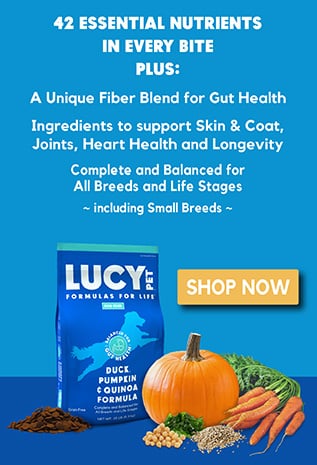










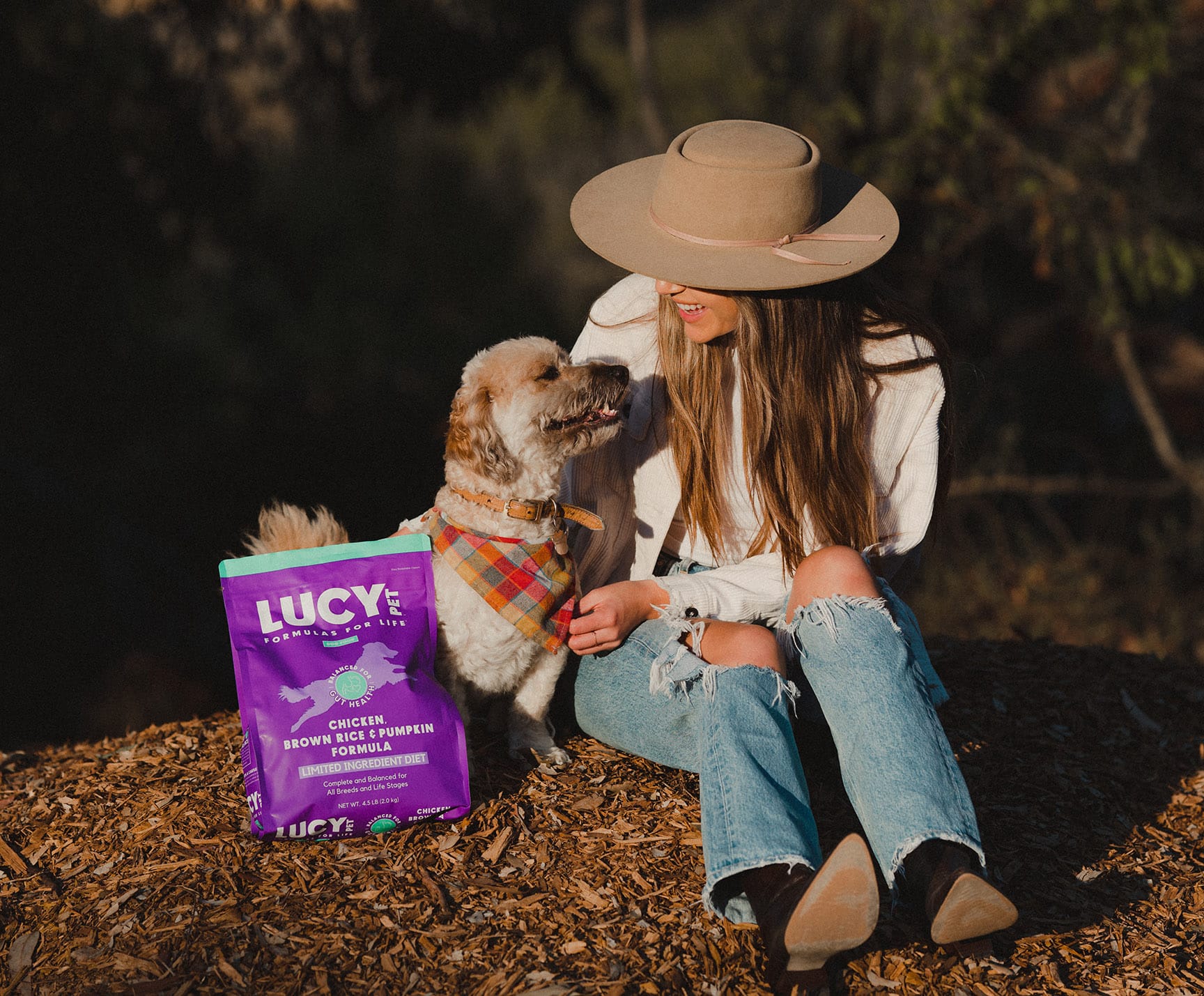

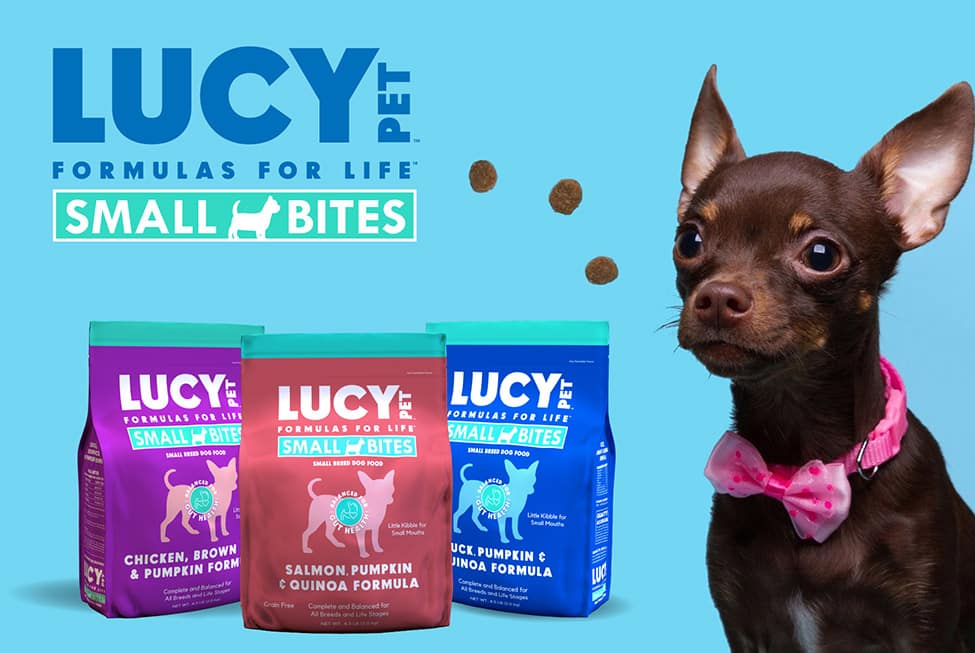
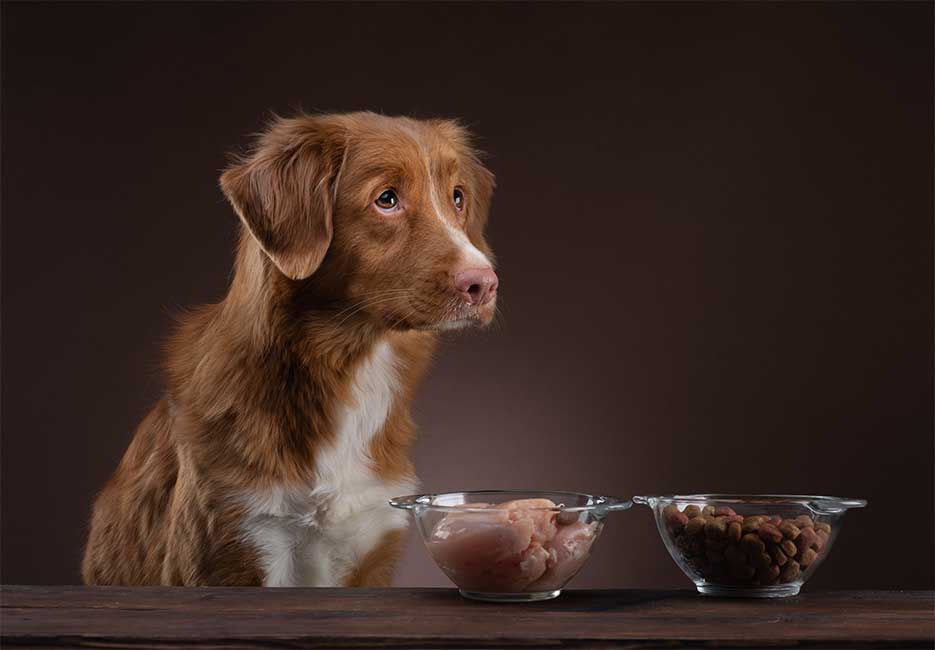
Owen Aston says:
Lorraine Winokur says: